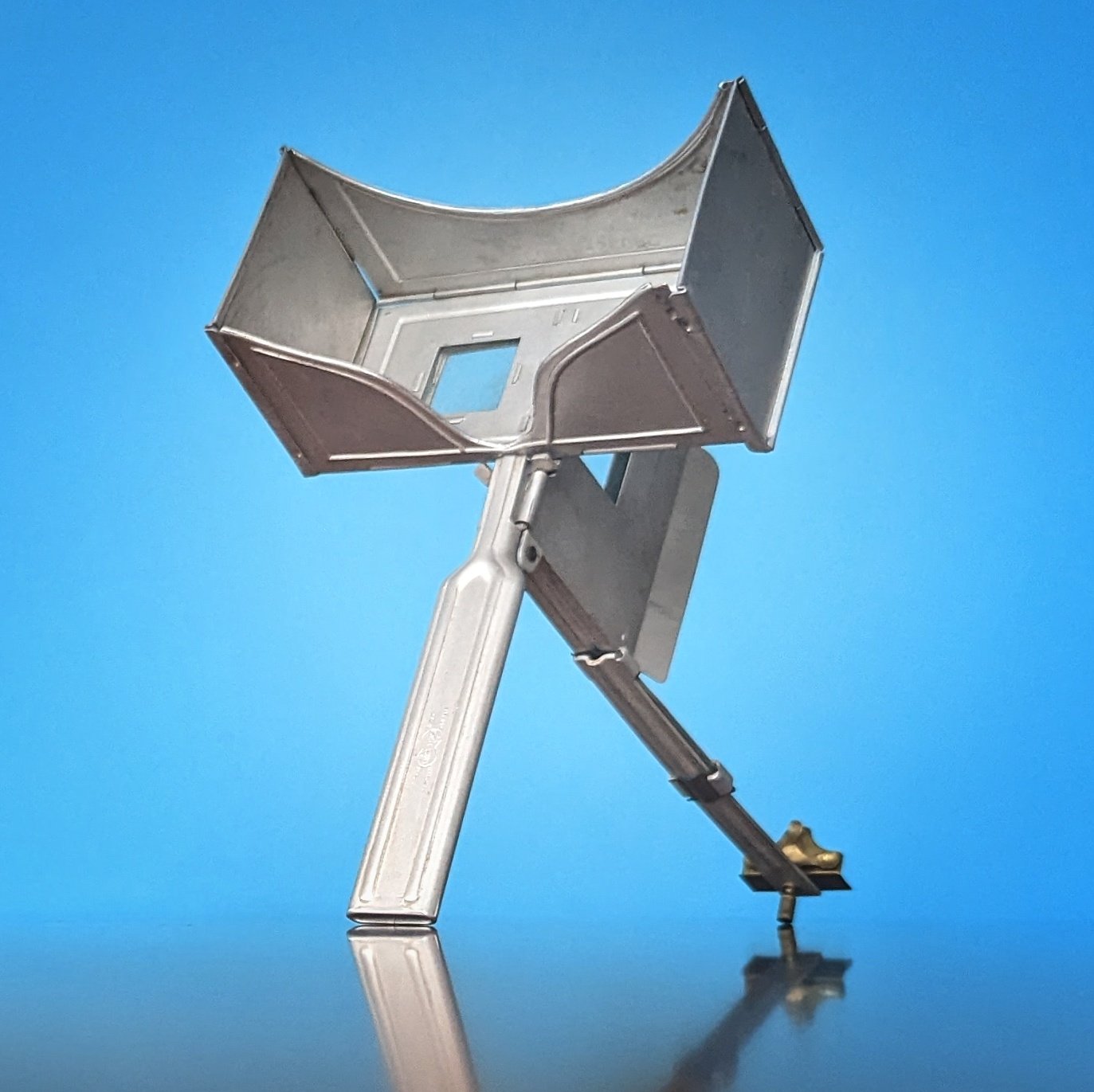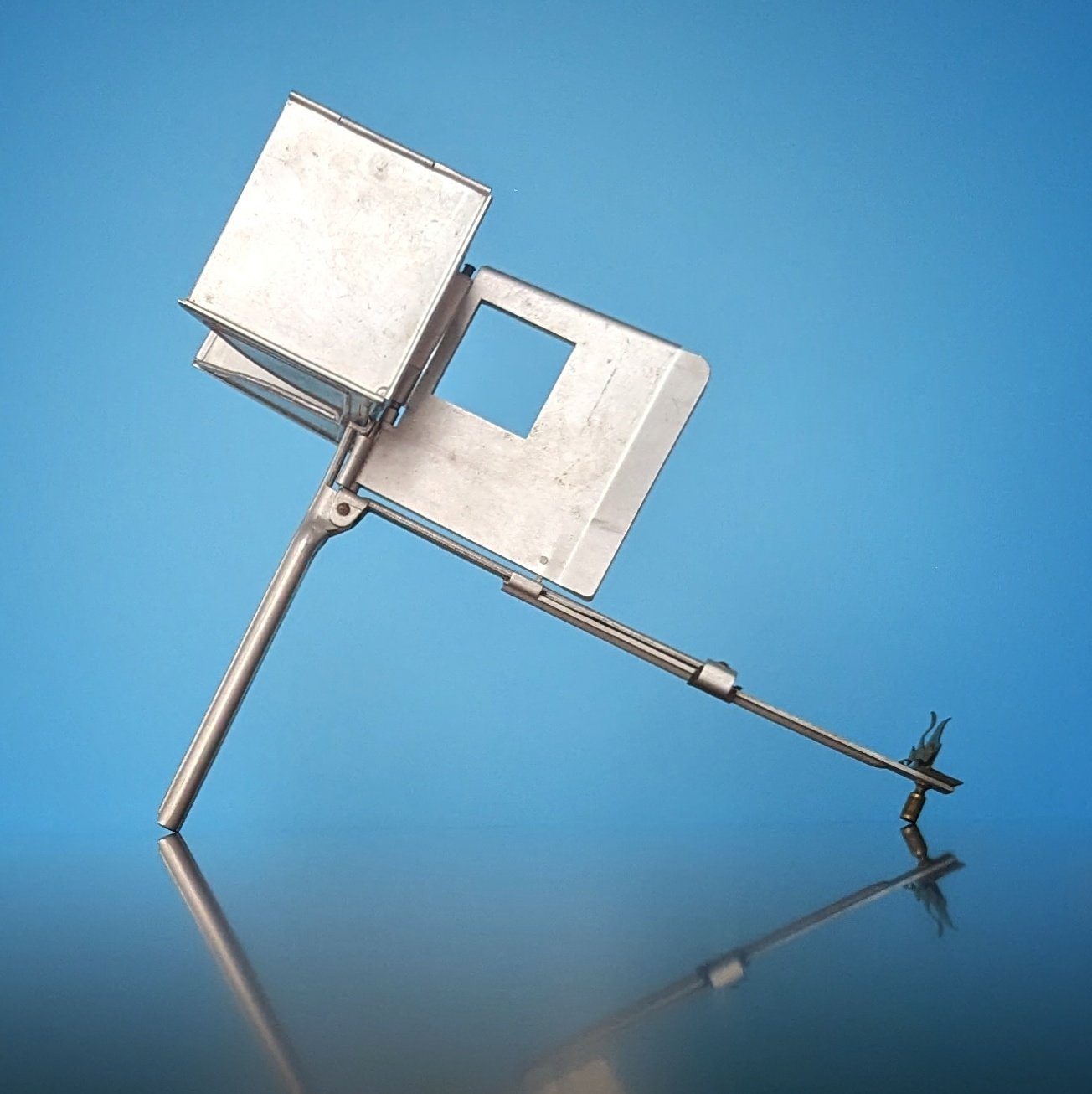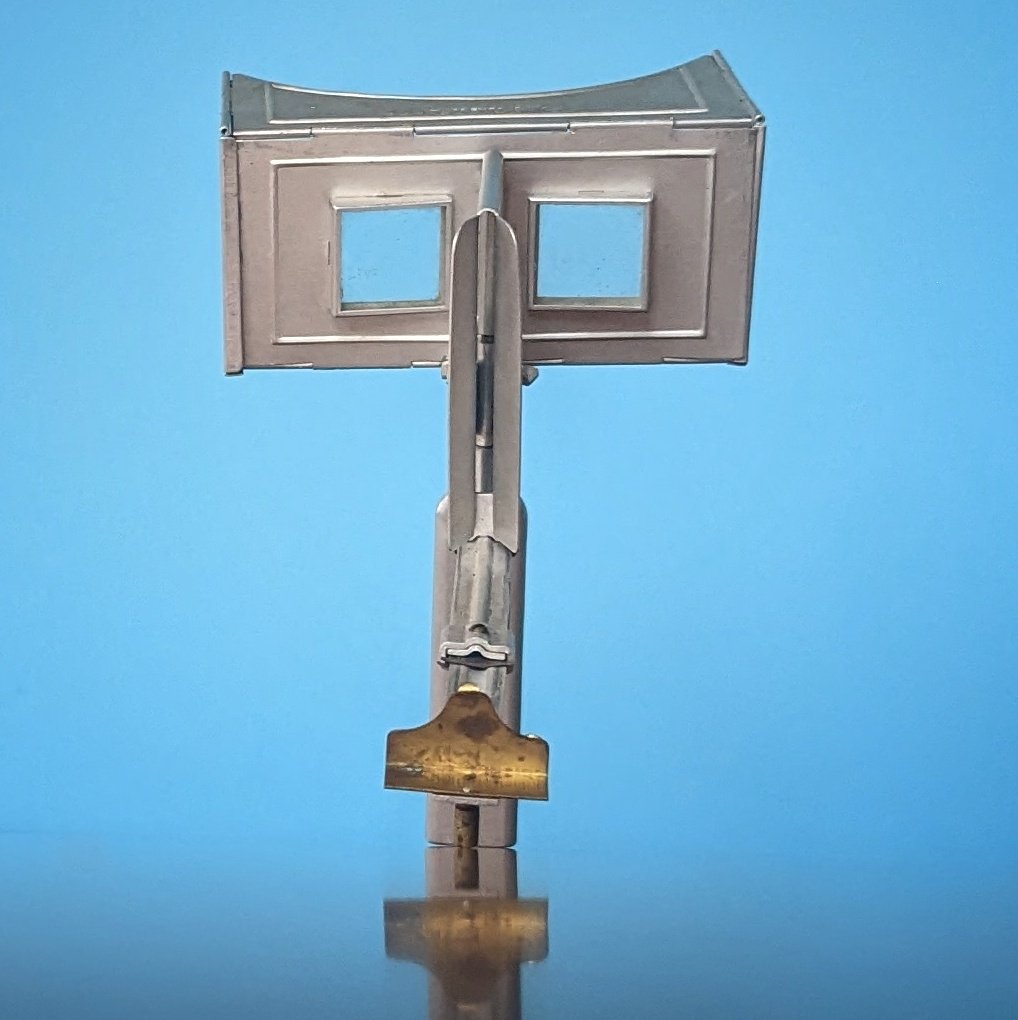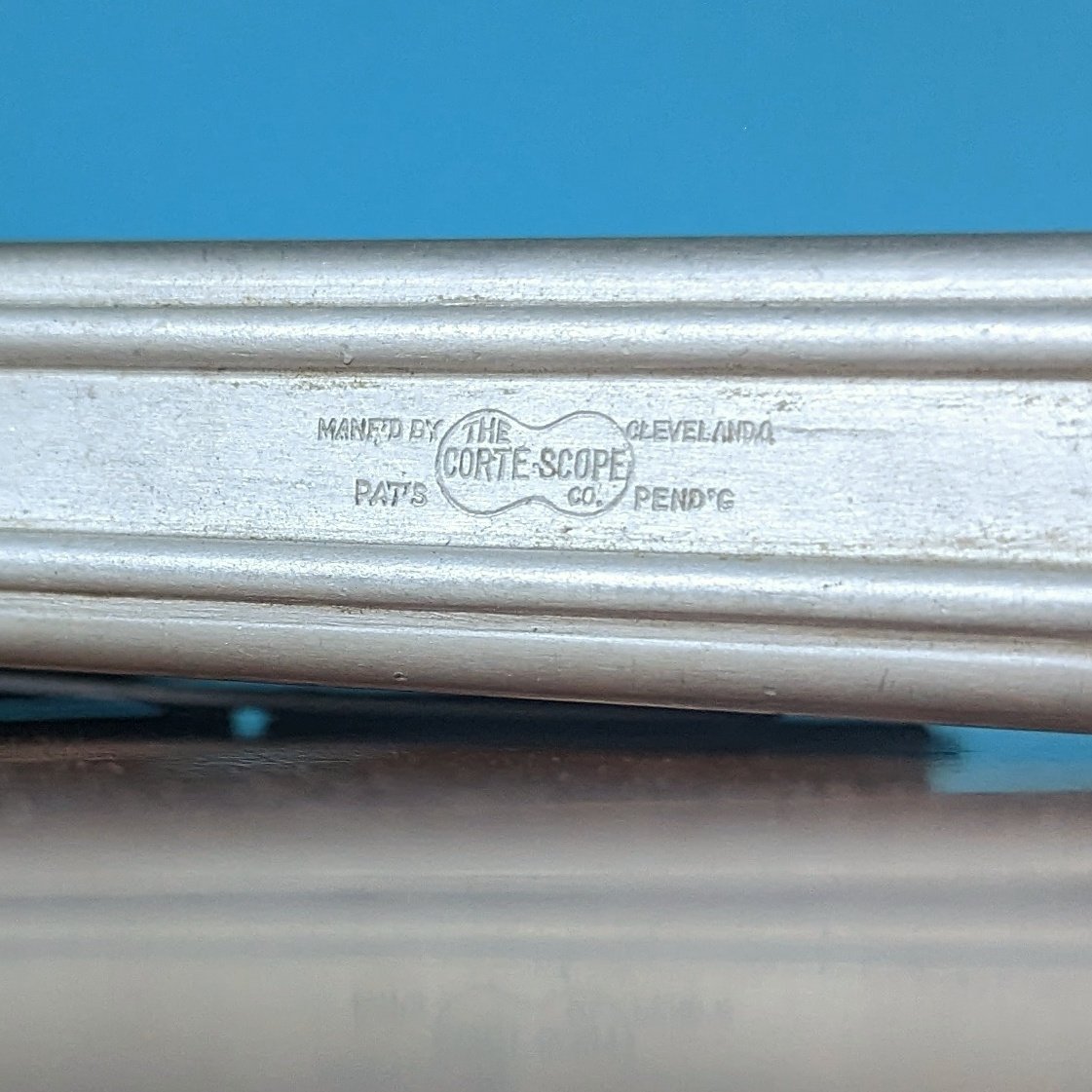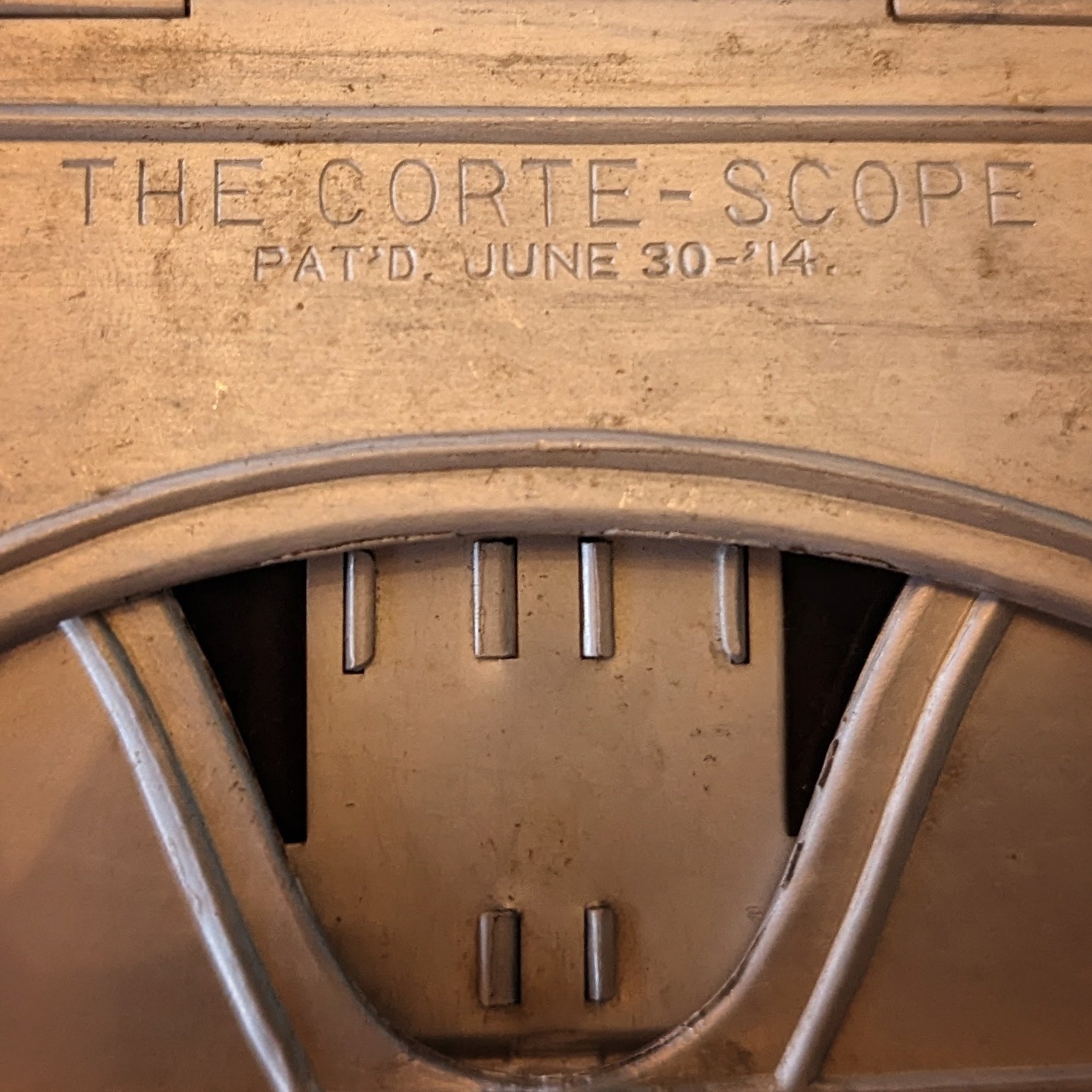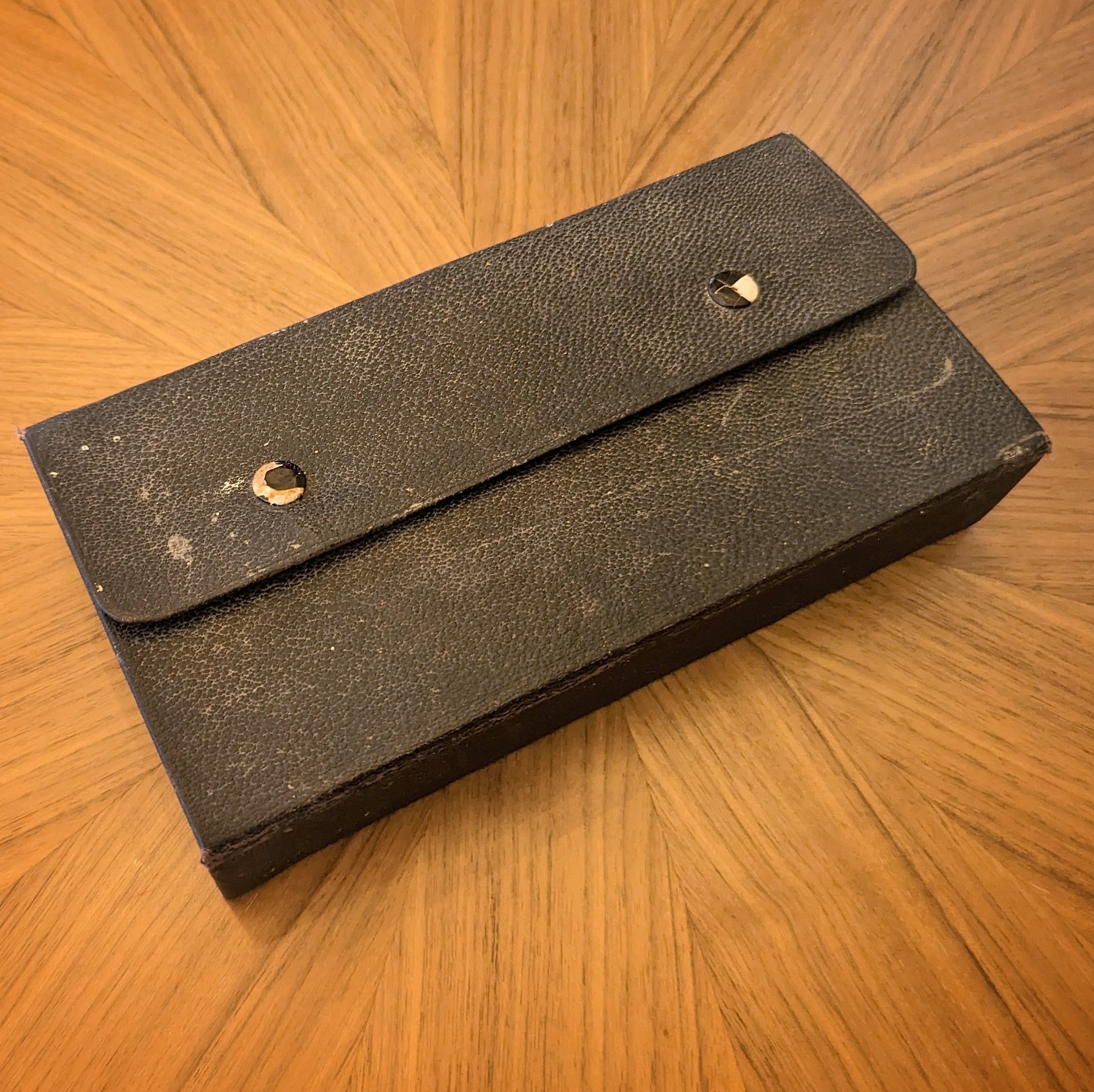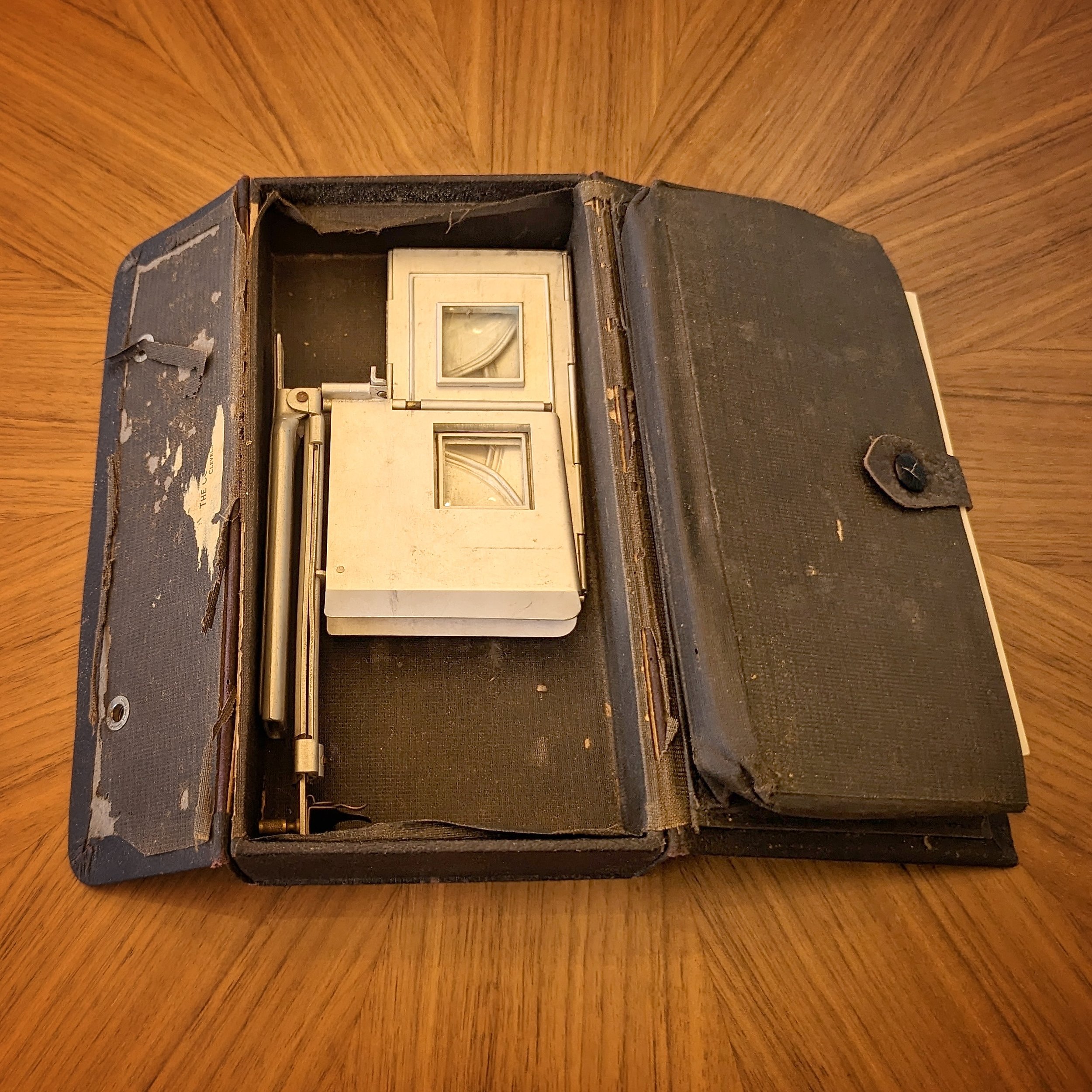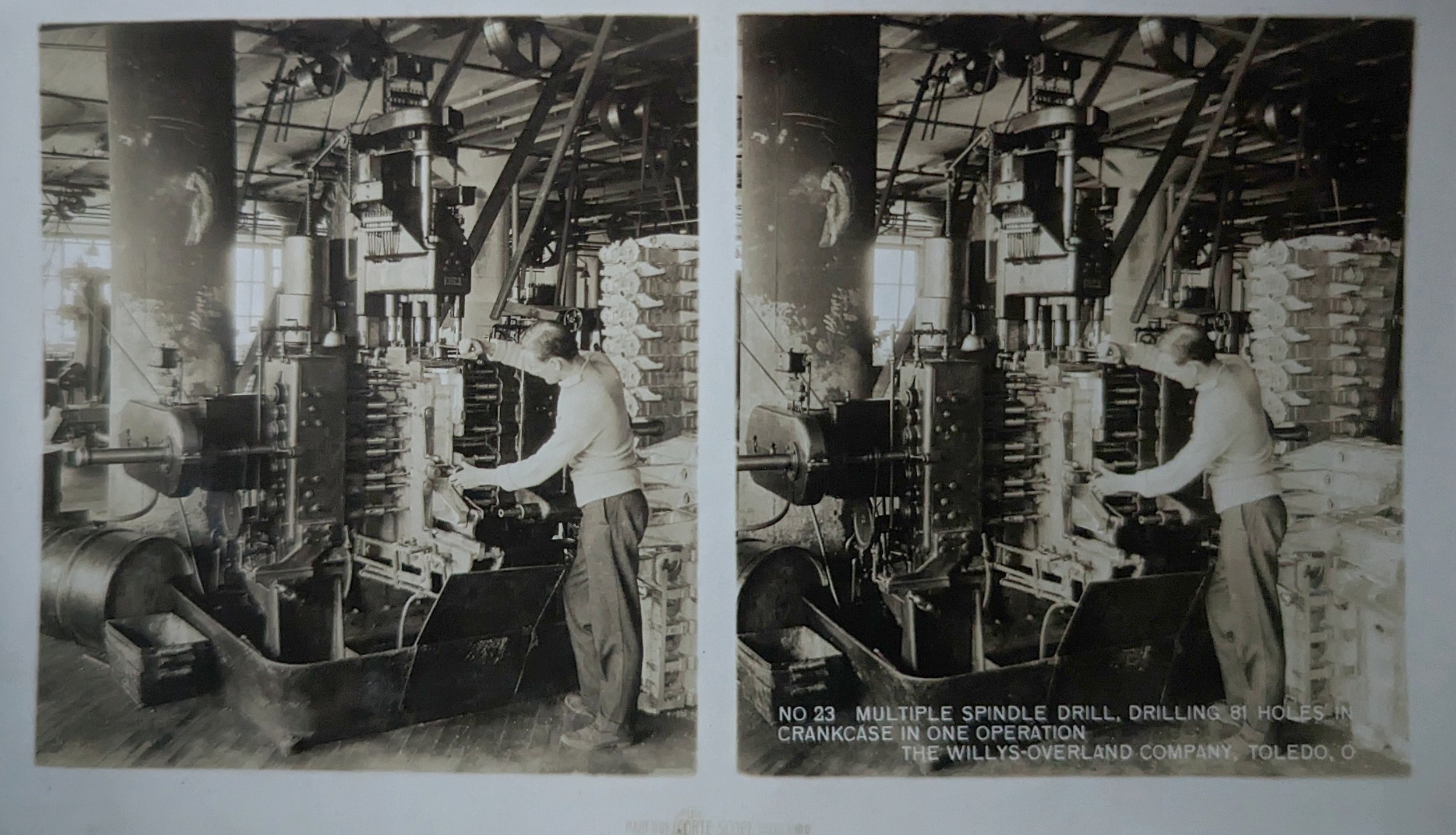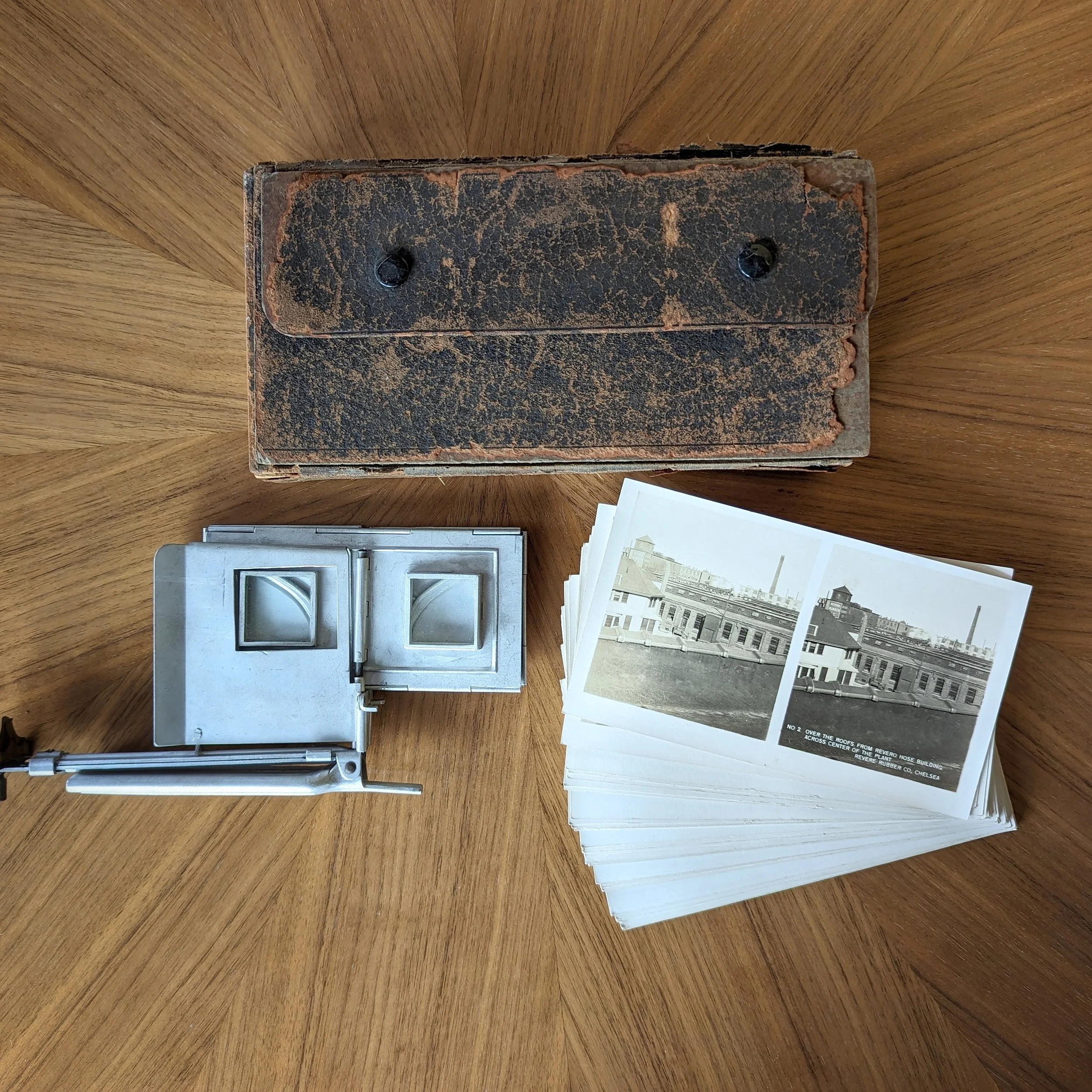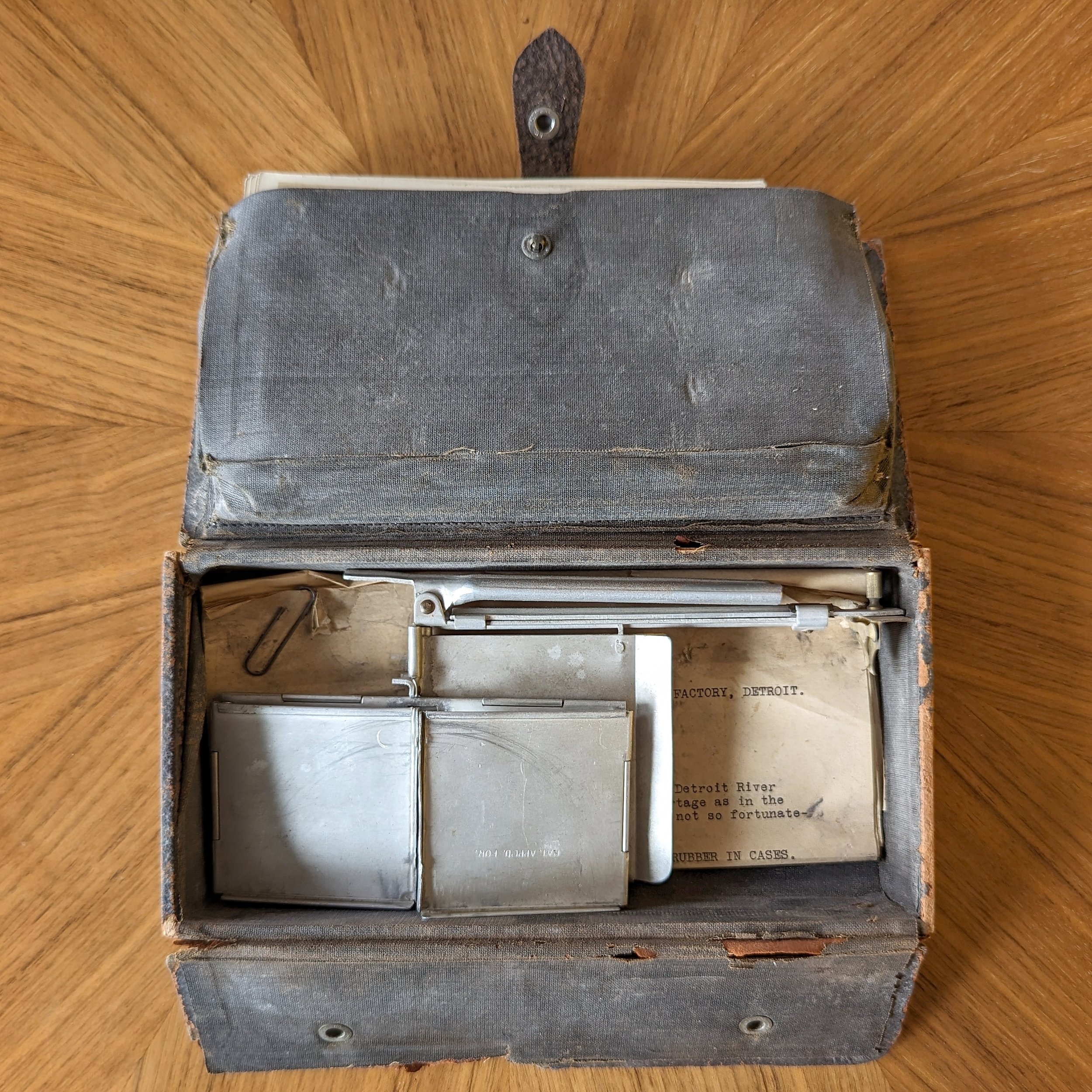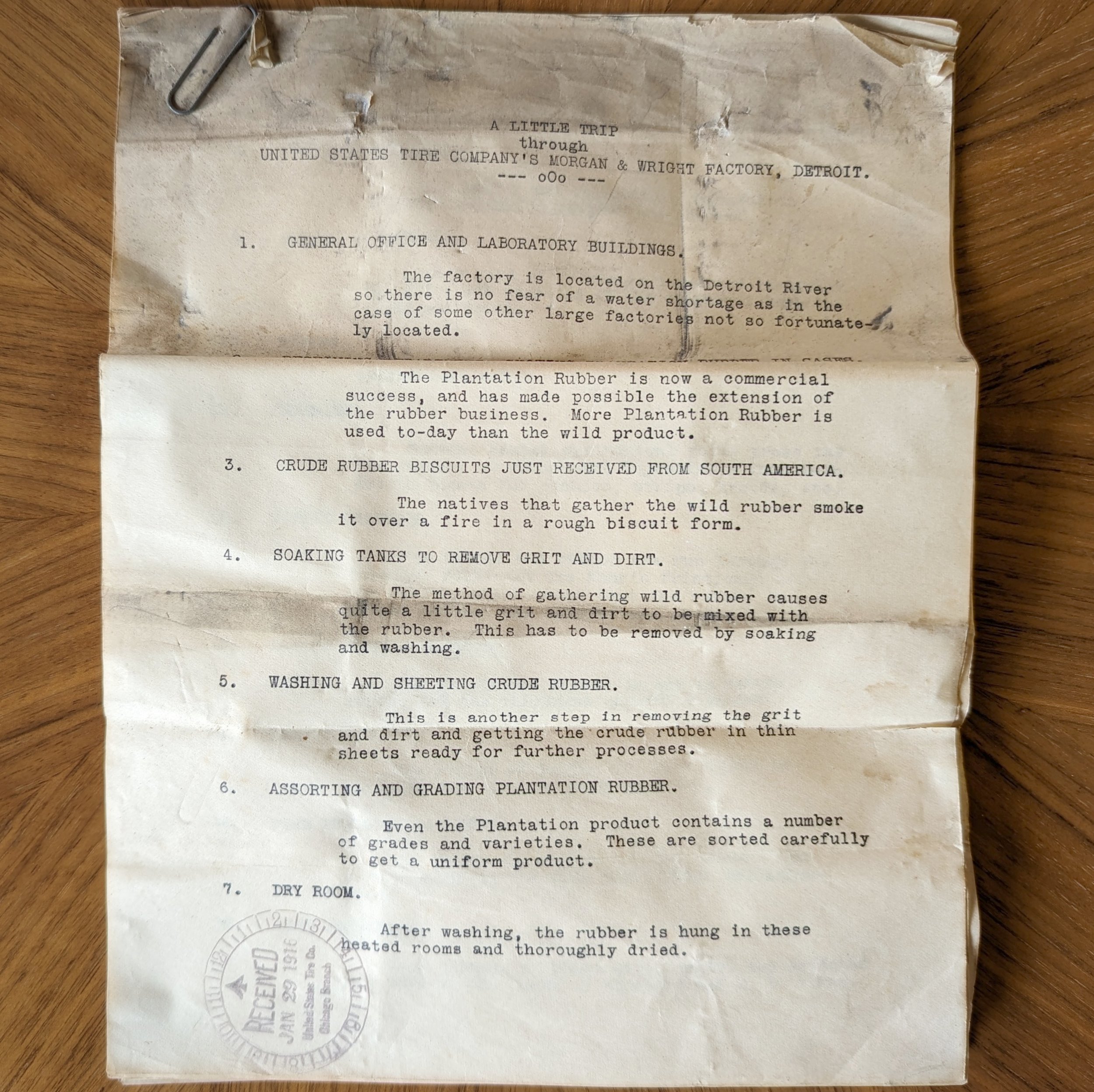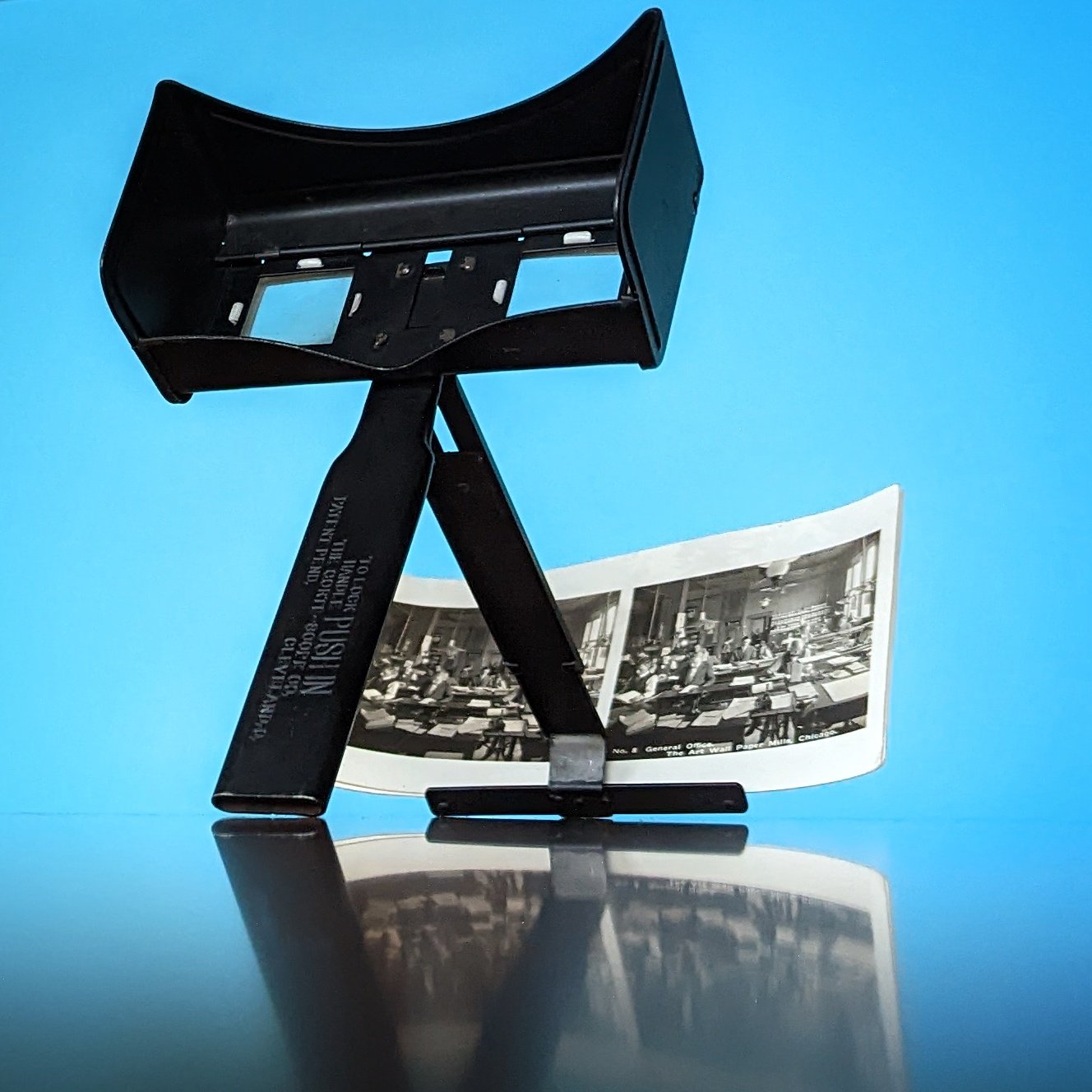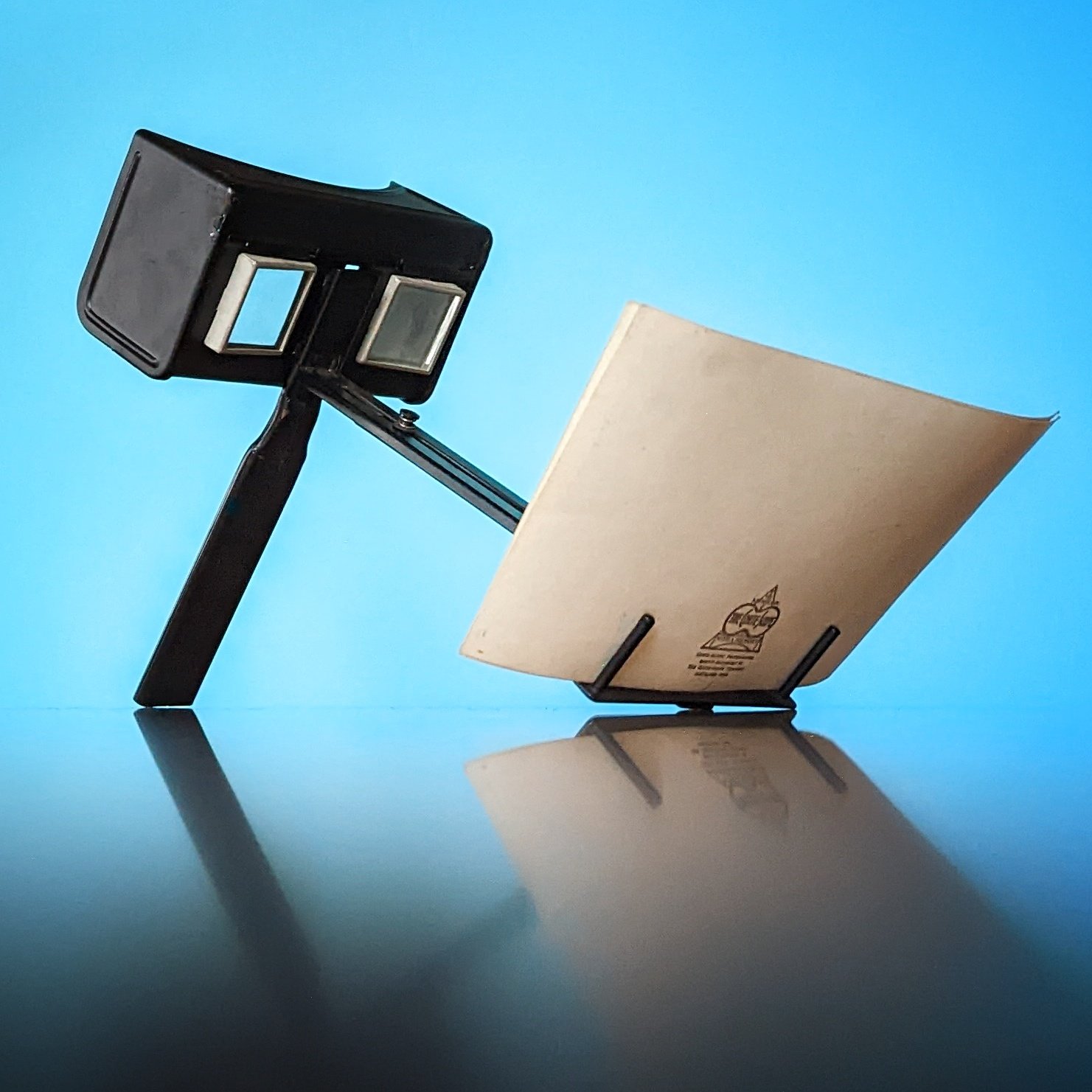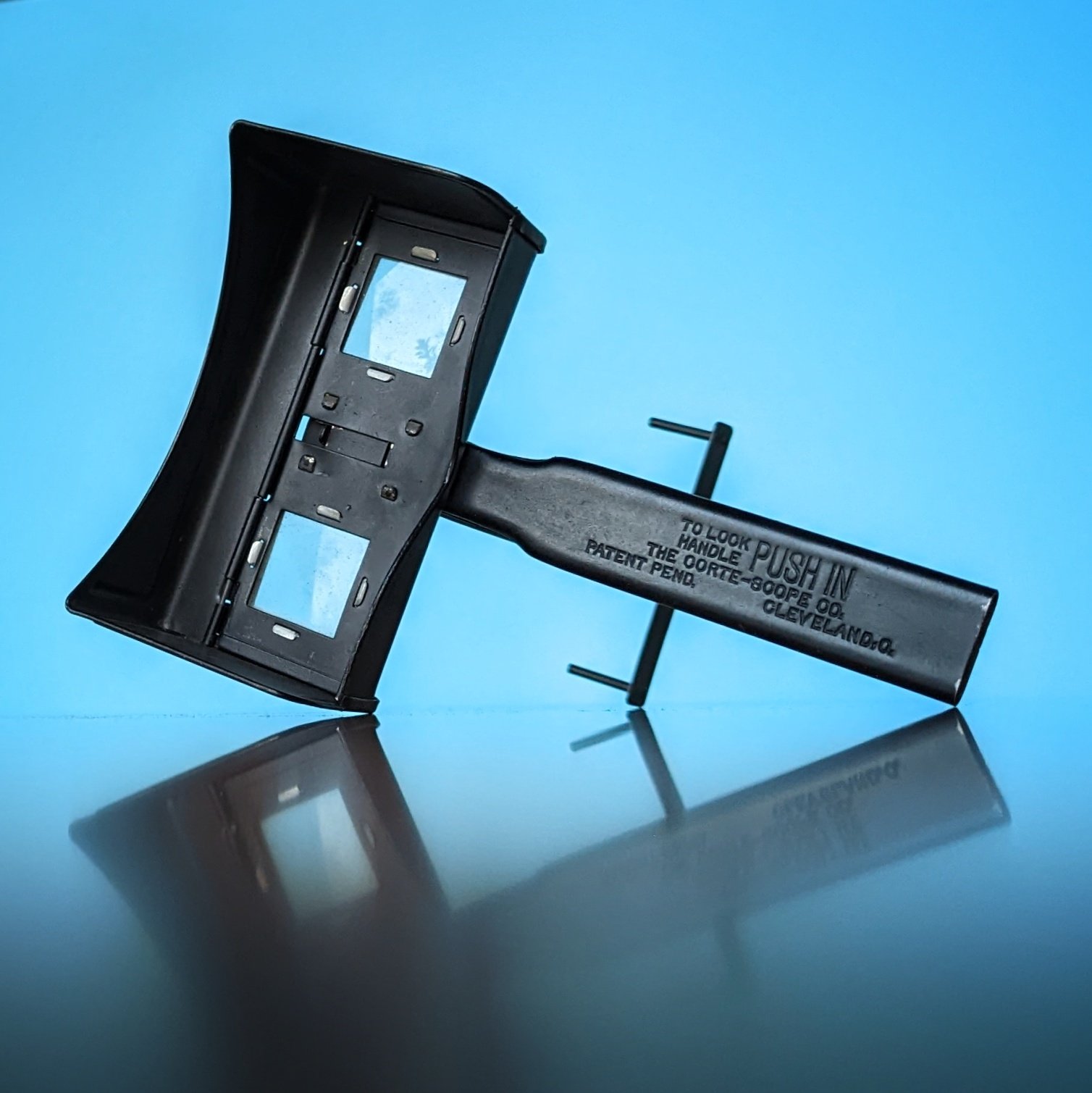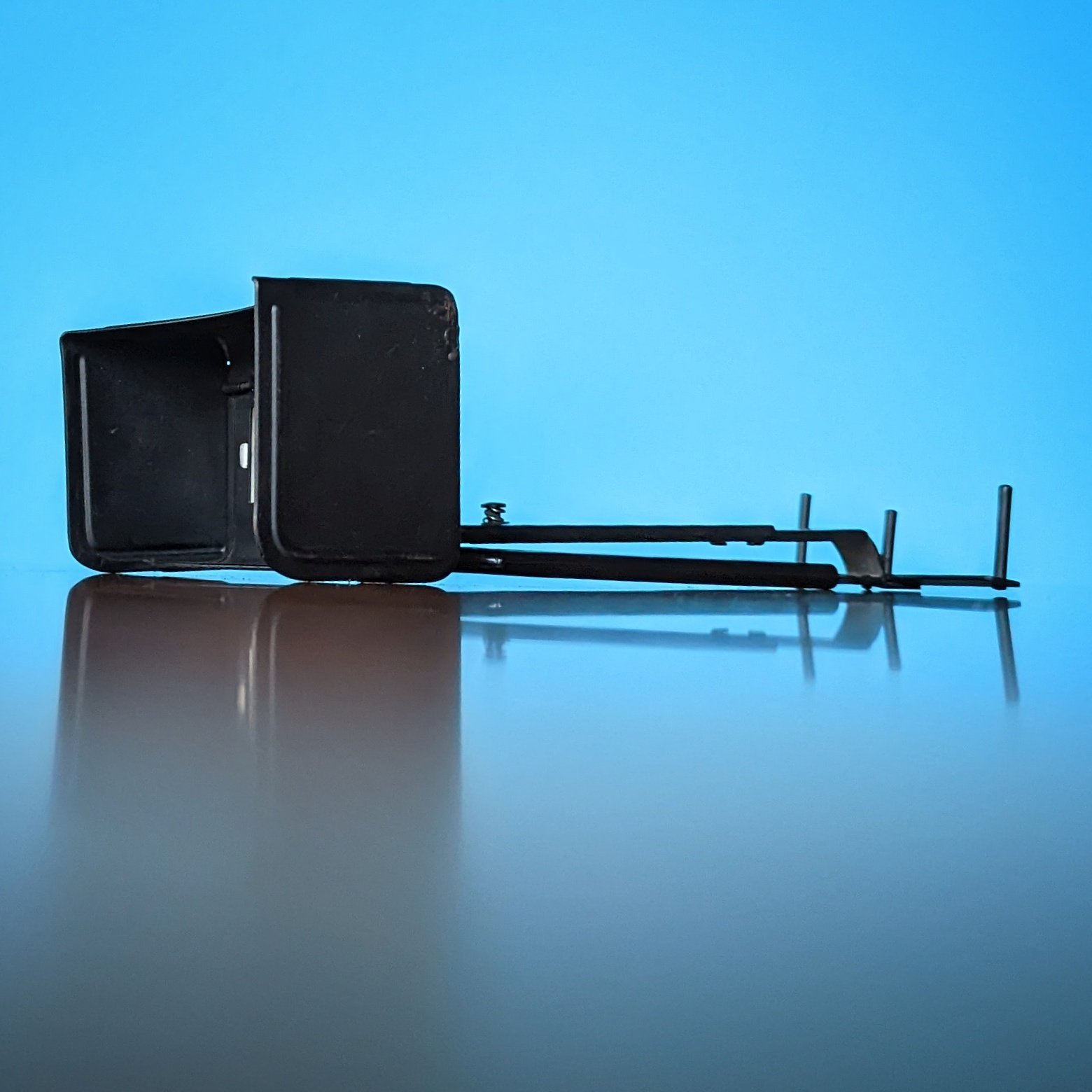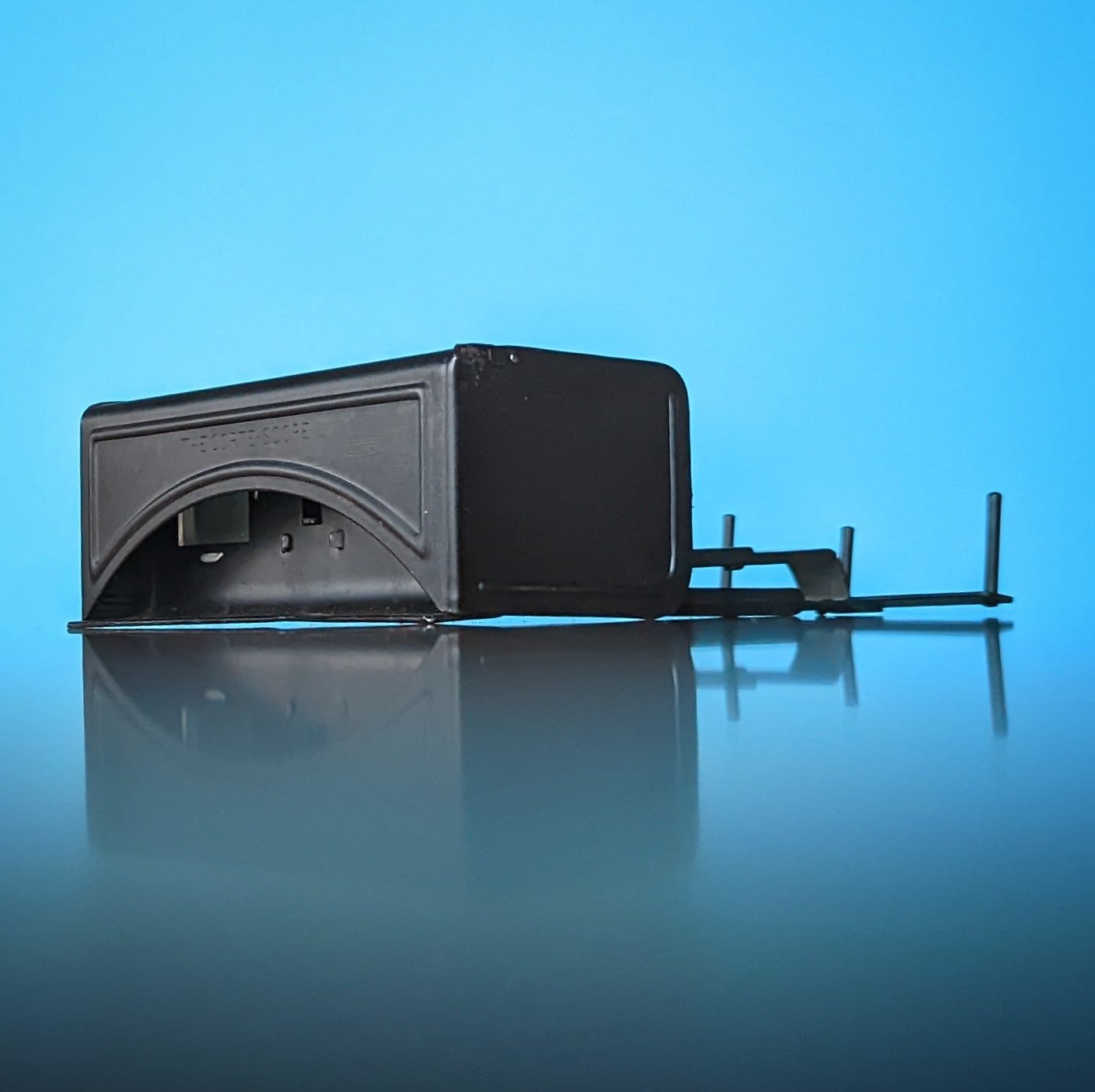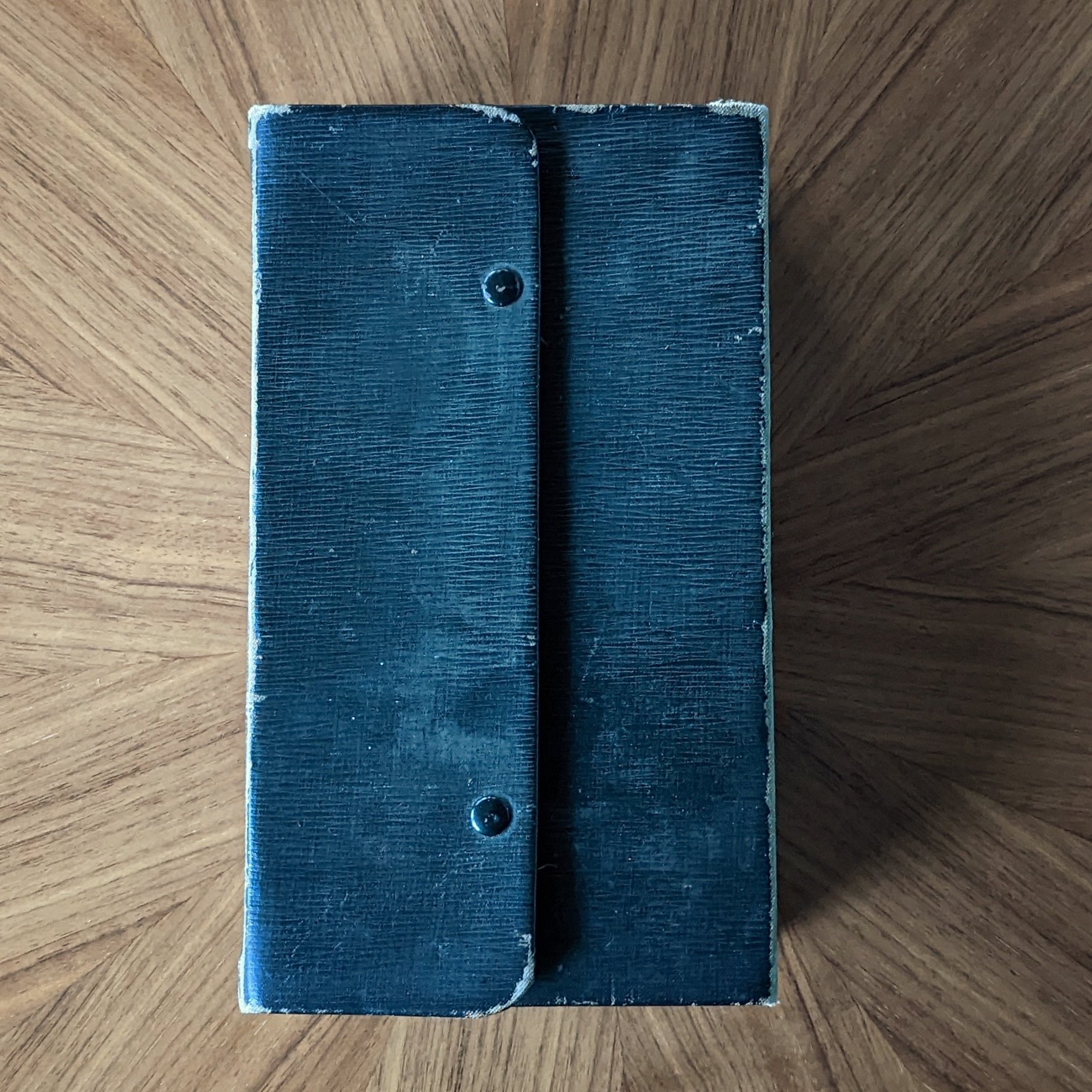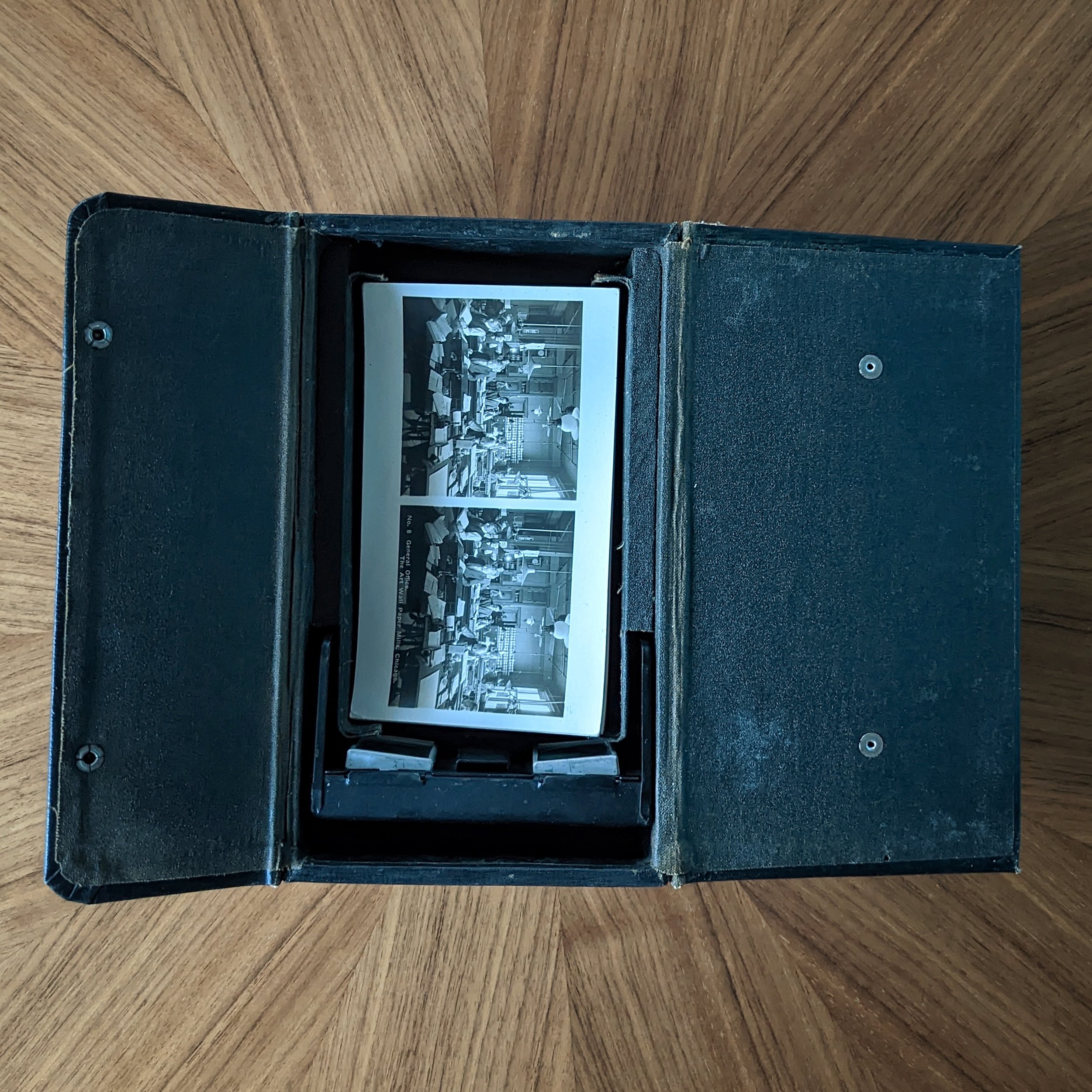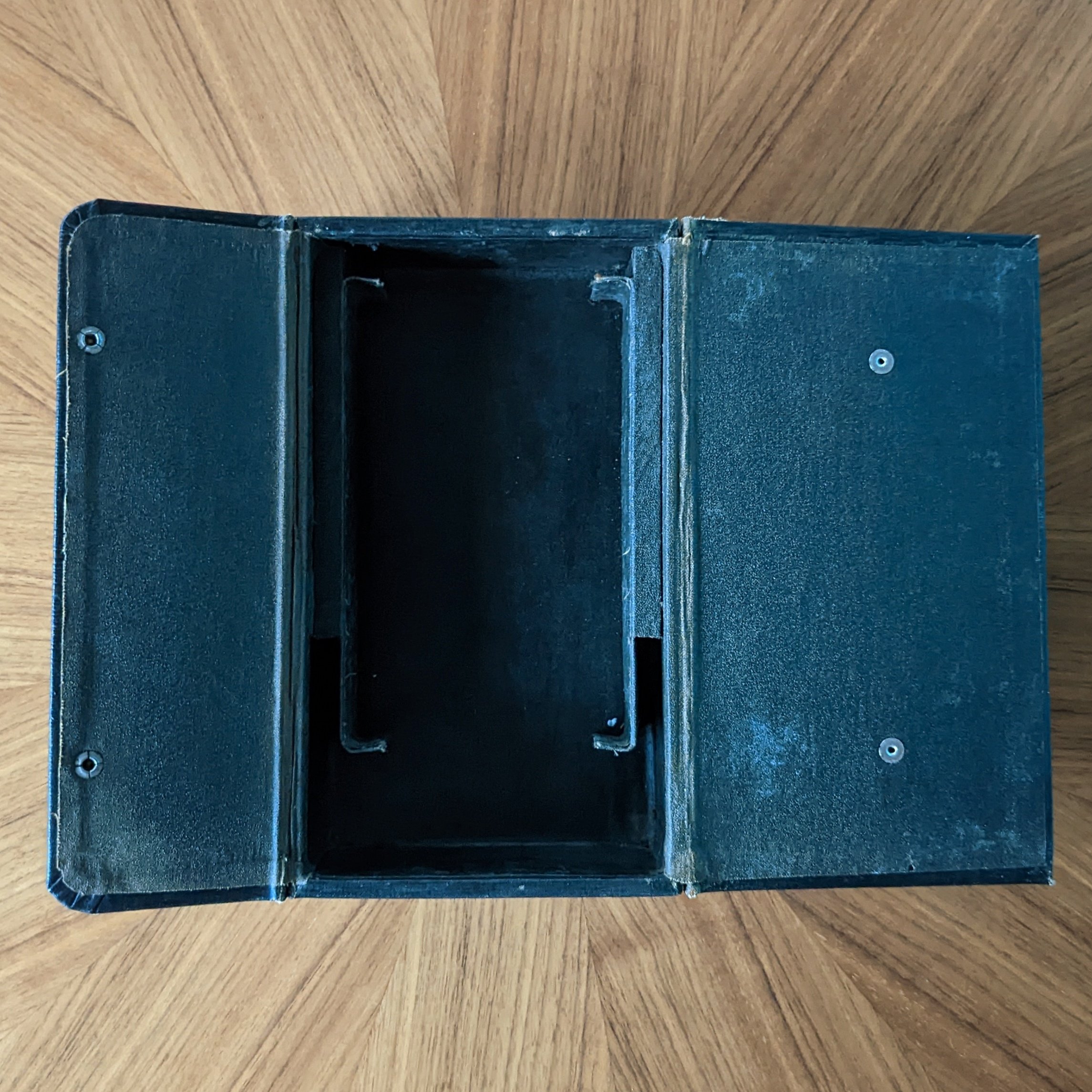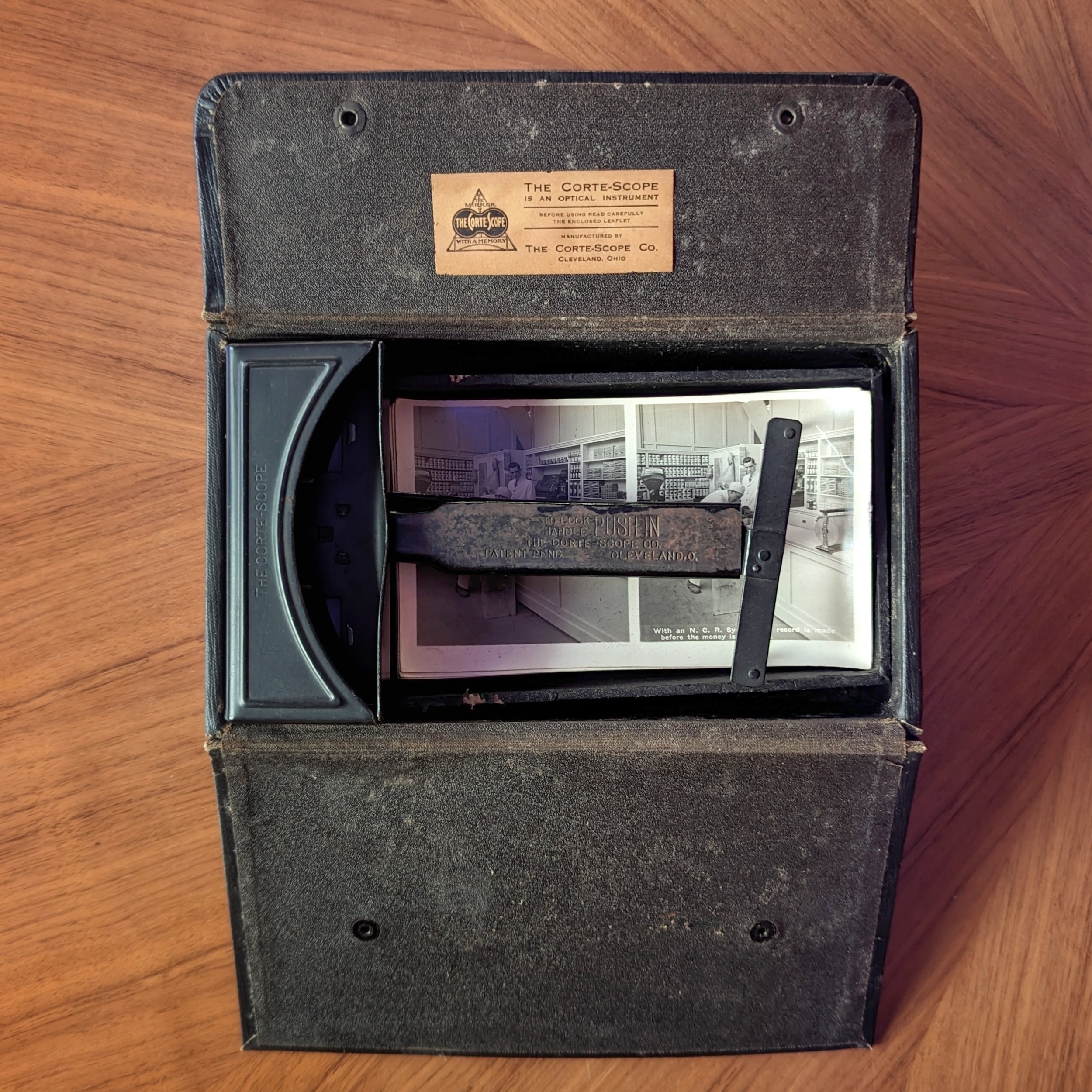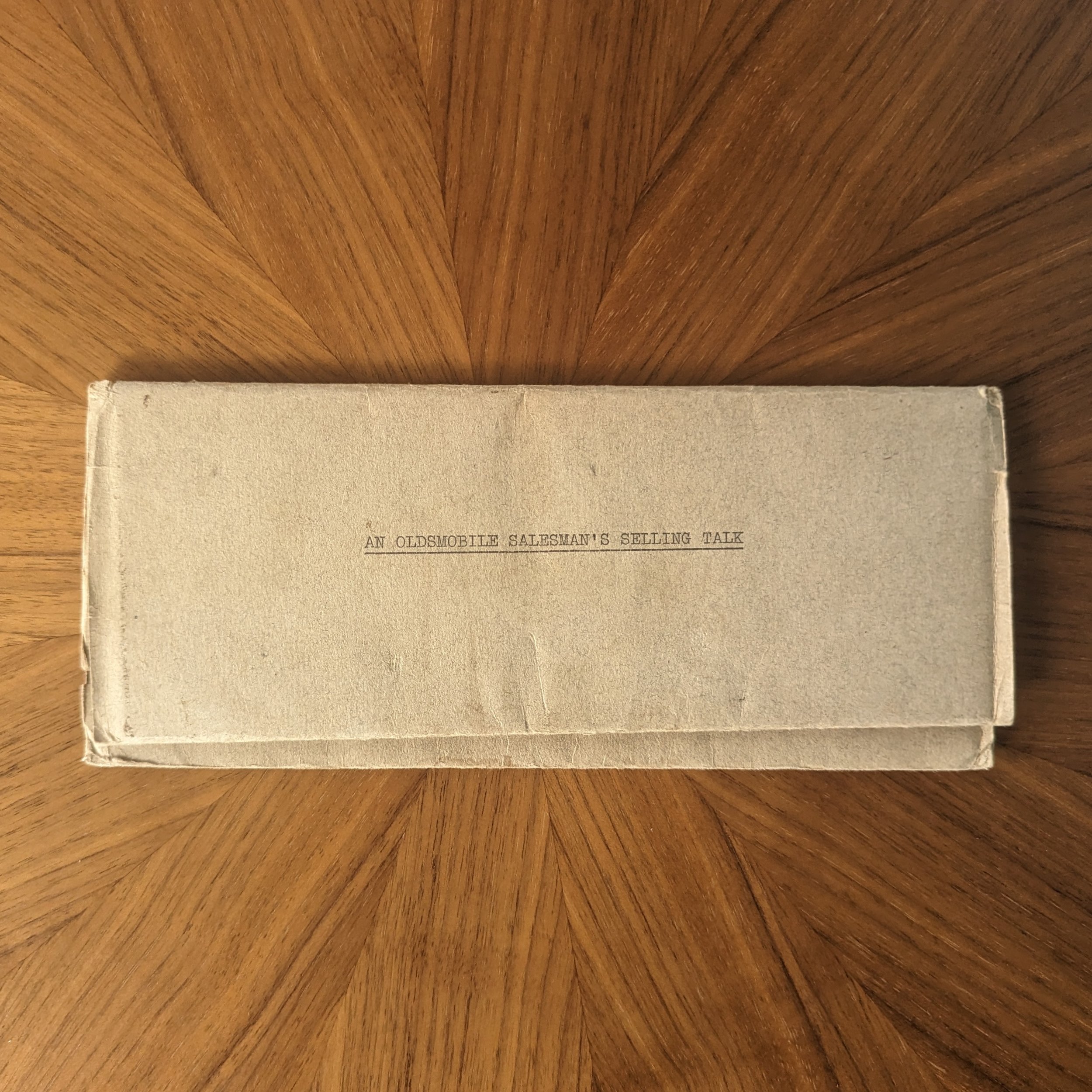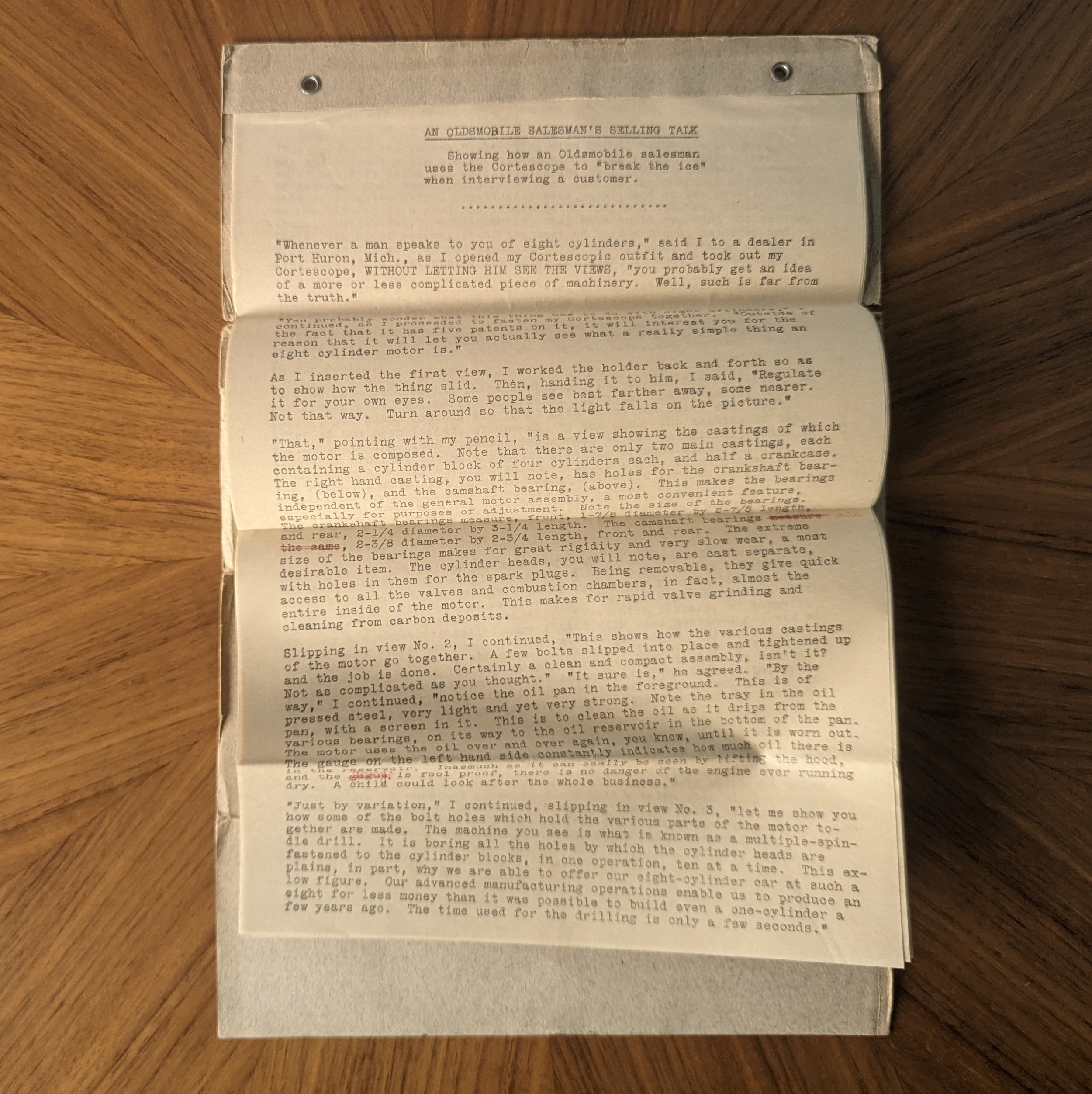Corte-Scope Stereoscope
United States, 1910s
Designed specifically for salesmen, Corte-Scope stereoscope sets were one of the very early 3D advertising systems, specializing in stereoscopic views for a wide range of industries. The Corte-Scope founders realized that the unwieldly shape & size of previous stereoscopes made commercial use impractical, even though marketing and sales were excellent applications of 3D. To address this, Corte-Scope sets were made compact for portability and included a collapsible, metal stereoscope and a set of “Corte-Scopic photographs” of the salesman’s products, factory, and equipment. These titled stereo photographs didn’t need cardboard mounting and could be made for a low cost. With a Corte-Scope set, salesmen wouldn’t need to carry heavy samples to show their customers but would still be able to get them interested enough to either make a purchase on the spot or go visit the salesman’s store or factory. The company stated that “the main point is to get goods clearly enough before [the buyer’s] eyes and in his mind so that he will take some kind of action” and boldly claimed “the difference between Corte-Scopic and ordinary photographs is so great that it is almost useless to make comparison.”
Starting out as the American Corte-Scope Company in 1911, the company opened offices at 5612 Carnegie Avenue, Cleveland, Ohio in 1915, reorganized under the shorter name Corte-Scope Company in 1916 and officially filed for the right to use the “Corte-Scope” product name, claiming use since 1911. There were different designs and patents for the Corte-Scope stereoscope as it evolved. There’s a silver version and at least 2 black versions. Some sets had a seal grain leather carrying case, others had a cardboard carrying container.
Primary Material: Metal
Media Format: Photo paper
Light Source: Natural light
Focus: Adjustable
Interocular: Fixed
Corte-Scope: The Willys-Overland Company
The hood of our silver Corte-Scope is imprinted with the patent date of June 30, 1914 even though the handle still says “pat’s pend’g”. It comes with a set of stereoviews of The Willys-Overland Company, an automotive company founded in Toledo, Ohio in 1908 when John Willys (pronounced “Willis”) purchased Overland Automotive from the Standard Wheel Company. The stereoviews show company buildings and company employees working on motors, valves, carburetors and more. Along with image descriptions printed on the front of each stereoview, the Corte-Scope logo is also printed on the front, though it’s barely visible on some. The Willys-Overland Company existed until the 1950s and at one time was only second to Ford in U.S. automobile production.
Corte-Scope: Revere Rubber
Revere Rubber, a division of the United States Rubber Company, had branches across the United States, including their main Boston branch, and others in Pittsburgh, New York, Chicago, and other cities. Their manufacturing plants were in Chelsea, Massachusetts, and Providence, Rhode Island. This set documents the Chelsea, Massachusetts factory. Revere produced various products: hoses, belting, horseshoe pads, pump valves, tires, and tubes. One of their products, the “Revero” garden hose, is featured in one of the stereoviews below.
Corte-Scope: U.S. Tire Company, Morgan & Wright Factory
We were happy to find that this Corte-Scope set still contained the sales talk script dated as being received on January 29, 1916. The stereoviews document the workings of the U. S. Tire Company’s Morgan & Wright factory in Detroit.
Morgan & Wright, founded in Chicago, Illinois, had once produced more bicycle tires than any other plant. The growing automotive industry prompted their move to Detroit in 1905-06. A few years later, the United States Rubber Company purchased Morgan & Wright and would eventually produce more tires than any other manufacturer worldwide.
The United States Tire Company, the name in the caption of most of the stereoviews, handled the marketing for United States Rubber. There’s also a set of separately numbered stereoviews that specifically reference United States Rubber, mostly documenting their New York buildings.
In 1961, the company became Uniroyal. In 1990, Michelin purchased Uniroyal and continues to produce products under the Uniroyal brand today. The factory itself closed in 1980 and was torn down in 1985. For those interested specifically in the historical aspects of the factory building and its impact on Detroit, see this Uniroyal article.
Corte-Scope: The Art Wall Paper Mills
Our black Corte-Scope comes with a set of stereoviews of The Art Wall Paper Mills of Chicago, a wallpaper manufacturer that had been around for several years but officially incorporated in Chicago in 1900. The patent application for the stereoscope shown below was filed February 23, 1917 by Harry N. Clarke and its patent #1252089 was granted in January of 1918. Harry would also serve as president of the Corte-Scope company.
Design Notes: Unlike the silver Corte-Scope above, this one doesn’t fold completely flat so it’s more sturdy when it’s assembled. Instead of the full Corte-Scope logo on the handle, that space is used to provide instructions for locking the handle in place — something that’s not easy to figure out with the silver Corte-Scope. Additionally, the wider cardholder keeps the view more stable than the smaller one provided on the silver Corte-Scope. On the stereoviews, the Corte-Scope logo is on the back, rather than the front as in the set above.
Corte-Scope: National Cash Register (NCR)
NCR — today, known as NCR Voyix — was founded in Dayton, Ohio in the 1880s after acquiring the first mechanical cash register and its patents from its inventor, James Ritty. NCR had many perks, comparable to many of today’s tech companies: bath/shower facilities, physical workouts, clubs, and medical facilities (shown in one of the stereoviews below.) They also pioneered the idea of getting a receipt when making a purchase.
Fun fact about this set: the NCR stereoviews have a storytelling aspect. The images aren’t limited to just product and factory shots with explanatory text. Some of the stereoviews and their captions paint a picture of the business problems they solve and what can happen if you don’t use their products.
Corte-Scope: Oldsmobile Salesman’s Selling Talk
This is a wonderful piece of vintage viewer literature “showing how an Oldsmobile salesman uses the Cortescope to ‘break the ice’ when interviewing a customer.” There’s so much to love here including the first-person suspenseful narrative, the step-by-step and view-by-view talking points, and the sales-y tips and tricks such as:
“NOTE! Always insert a new view while taking one out, so there is always something to look at while talking. It is generally wise also to withdraw the last view before taking the instrument, as it is then given up willingly, your prospect feeling that the show is over.”
